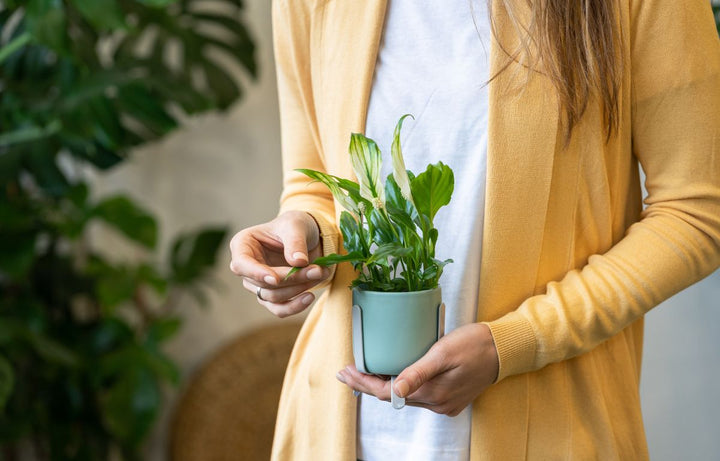
Acclimatising Your Houseplants
Acclimatising Your Houseplants
Houseplants often face challenges when environmental conditions shift dramatically. Acclimatising your houseplants to extreme conditions is crucial for their survival and well-being, whether it's a sudden temperature drop, a heatwave, or changes in humidity. Here’s a comprehensive guide to help your green friends thrive in challenging environments.

Understanding the Challenges
Temperature Fluctuations: Houseplants can be sensitive to sudden changes in temperature. Both cold snaps and heatwaves can cause stress, leading to wilting, leaf drop, or even death.
- Humidity Levels: Many houseplants, especially tropical varieties, thrive in high humidity. Dry indoor air, particularly during winter, can lead to brown leaf tips and other issues.
- Light Intensity: Changes in light availability, such as reduced daylight in winter or intense summer sun, can affect your plants' growth and health.
- Watering Needs: Extreme conditions can alter a plant's water requirements. Understanding and adjusting your watering routine is essential to prevent overwatering or dehydration.
Care and Maintenance Tips
Gradual Acclimatisation:
- Introduce Changes Slowly: When moving plants to new conditions, do so gradually. For instance, if relocating a plant to a sunnier spot, increase light exposure incrementally over a few weeks.
- Seasonal Adjustments: Prepare plants for seasonal changes by gradually adjusting their environment. For example, slowly reduce watering as you approach winter when plant growth typically slows.
Temperature Management:
- Avoid Draughts: Keep plants away from cold draughts or sudden temperature changes, such as those near doors and windows.
- Use Insulation: For plants near windows, consider using insulating curtains or blinds to buffer against extreme cold or heat.
Humidity Control:
- Increase Humidity: Use a humidifier, mist your plants regularly, or place them on a tray filled with water and pebbles to increase humidity.
- Group Plants Together: Grouping plants creates a microenvironment that naturally produces humidity. This is especially beneficial for humidity-loving species that are exposed to dry hot or cool air.
Light Adjustment:
- Supplemental Lighting: Use grow lights during winter or in low-light conditions to ensure your plants receive adequate light.
- Shade in Summer: Protect plants from intense summer sun by using sheer curtains or moving them to a slightly shadier spot.
Watering Practices:
- Adjust Watering Frequency: In extreme heat, plants may need more frequent watering. Conversely, during colder months, reduce watering to prevent root rot.
- Check Soil Moisture: Always check soil moisture before watering. The top inch of soil should be dry before you water again, especially during cooler periods.

Specific Tips and Acclimatisation Methods for Common Houseplants
Philodendron Heart Leaf (Philodendron hederaceum):
- Light: Gradually move to brighter spots over a week to prevent shock.
- Water: Reduce watering frequency as light decreases.
- Humidity: Increase humidity by misting or using a pebble tray during dry conditions.
Monstera Deliciosa:
- Light: Slowly increase exposure to bright, indirect light over a couple of weeks.
- Water: Adjust watering based on light levels, ensuring the top inch of soil dries out between waterings.
- Humidity: Place a humidifier nearby or mist regularly to maintain high humidity.
Fiddle Leaf Fig (Ficus lyrata):
- Light: Transition to bright, indirect light gradually to avoid leaf burn.
- Water: Monitor and adjust watering as indoor temperatures change.
- Humidity: Place near a humidifier or mist regularly, especially in winter.
Devil’s Ivy (Epipremnum aureum):
- Light: Adapt to brighter light conditions slowly over several days.
- Water: Allow soil to dry slightly more between waterings in lower light.
- Humidity: Tolerates lower humidity but benefits from occasional misting.
Parlour Palm (Chamaedorea elegans):
- Light: Acclimate to moderate light by moving closer to a light source over a week.
- Water: Maintain consistent moisture but reduce watering in winter.
- Humidity: Mist frequently or use a humidity tray to keep humidity levels high.
Snake Plant (Sansevieria trifasciata):
- Light: Introduce to brighter light slowly; can tolerate direct sunlight if acclimated.
- Water: Ensure soil is dry between waterings, especially in winter.
- Humidity: Adaptable to various humidity levels; no special adjustments needed.

Bird of Paradise (Strelitzia reginae):
- Light: Gradually increase light exposure to ensure at least four to six hours of sunlight daily.
- Water: Adjust watering based on seasonal changes, keeping soil moist in summer.
- Humidity: Use a humidifier or mist regularly to maintain high humidity.
Alocasia (Alocasia spp.):
- Light: Move to brighter, indirect light gradually over two weeks.
- Water: Keep soil consistently moist, reducing slightly in winter.
- Humidity: Requires high humidity; use a humidifier or mist daily.
Peace Lily (Spathiphyllum spp.):
- Light: Transition to brighter light slowly to prevent leaf burn.
- Water: Maintain consistent moisture but reduce watering in winter.
- Humidity: Mist regularly or use a humidifier to keep humidity levels high.
Acclimatising houseplants to extreme conditions requires understanding their specific needs and making gradual adjustments to their environment. By managing temperature, humidity, light, and watering practices, you can help your houseplants not only survive but thrive despite challenging conditions. With proper care and attention, your indoor garden can continue to flourish, bringing beauty and vitality to your home no matter the season.
